Auditing and Investigations: Fraud Prevention and Detection
VerifiedAdded on 2020/05/01
|13
|3391
|43
Report
AI Summary
This report delves into the crucial role of internal auditors in preventing, detecting, and reporting fraud within companies. It highlights the significance of internal audit in both fraud prevention and detection, emphasizing its benefits for the organization, its stakeholders, and society. The report defines fraud, outlines different levels at which it can occur, and discusses effective fraud management programs. It explores various approaches to fraud management, including auditing, risk assessment, and consulting assignments. The report also examines fraud prevention and detection methods, such as codes of conduct, early warning signs, and internal control systems. It further details the roles of internal auditors in fraud detection, emphasizing their oversight function, knowledge of fraud schemes, and use of audit techniques. The report also discusses the internal auditor's professional standards, the application of agency theory, and different types of internal audits. Finally, it addresses the challenges faced by internal auditors, including advancements in fraudulent practices and the use of new technologies.
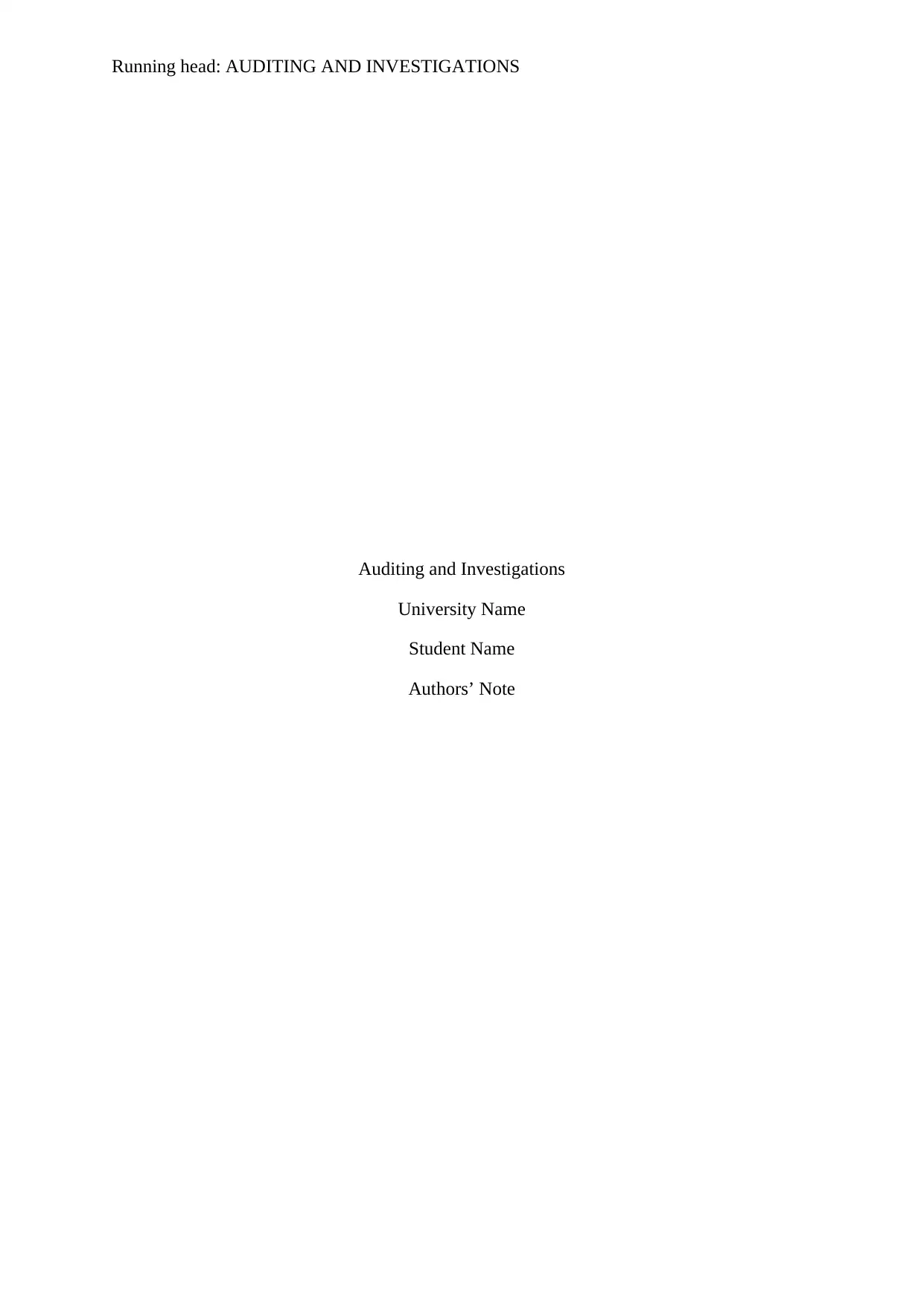
Running head: AUDITING AND INVESTIGATIONS
Auditing and Investigations
University Name
Student Name
Authors’ Note
Auditing and Investigations
University Name
Student Name
Authors’ Note
Paraphrase This Document
Need a fresh take? Get an instant paraphrase of this document with our AI Paraphraser
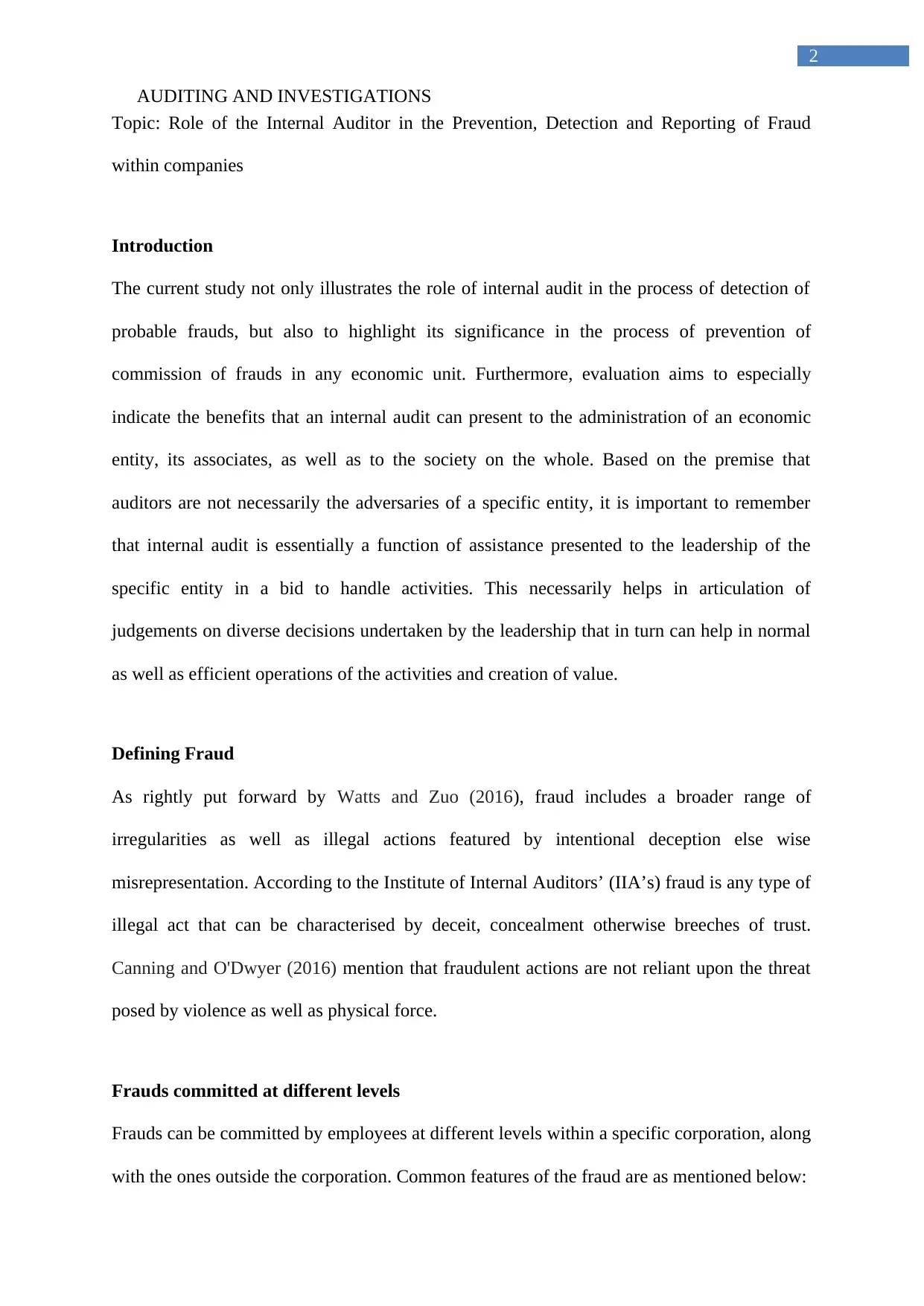
2
AUDITING AND INVESTIGATIONS
Topic: Role of the Internal Auditor in the Prevention, Detection and Reporting of Fraud
within companies
Introduction
The current study not only illustrates the role of internal audit in the process of detection of
probable frauds, but also to highlight its significance in the process of prevention of
commission of frauds in any economic unit. Furthermore, evaluation aims to especially
indicate the benefits that an internal audit can present to the administration of an economic
entity, its associates, as well as to the society on the whole. Based on the premise that
auditors are not necessarily the adversaries of a specific entity, it is important to remember
that internal audit is essentially a function of assistance presented to the leadership of the
specific entity in a bid to handle activities. This necessarily helps in articulation of
judgements on diverse decisions undertaken by the leadership that in turn can help in normal
as well as efficient operations of the activities and creation of value.
Defining Fraud
As rightly put forward by Watts and Zuo (2016), fraud includes a broader range of
irregularities as well as illegal actions featured by intentional deception else wise
misrepresentation. According to the Institute of Internal Auditors’ (IIA’s) fraud is any type of
illegal act that can be characterised by deceit, concealment otherwise breeches of trust.
Canning and O'Dwyer (2016) mention that fraudulent actions are not reliant upon the threat
posed by violence as well as physical force.
Frauds committed at different levels
Frauds can be committed by employees at different levels within a specific corporation, along
with the ones outside the corporation. Common features of the fraud are as mentioned below:
AUDITING AND INVESTIGATIONS
Topic: Role of the Internal Auditor in the Prevention, Detection and Reporting of Fraud
within companies
Introduction
The current study not only illustrates the role of internal audit in the process of detection of
probable frauds, but also to highlight its significance in the process of prevention of
commission of frauds in any economic unit. Furthermore, evaluation aims to especially
indicate the benefits that an internal audit can present to the administration of an economic
entity, its associates, as well as to the society on the whole. Based on the premise that
auditors are not necessarily the adversaries of a specific entity, it is important to remember
that internal audit is essentially a function of assistance presented to the leadership of the
specific entity in a bid to handle activities. This necessarily helps in articulation of
judgements on diverse decisions undertaken by the leadership that in turn can help in normal
as well as efficient operations of the activities and creation of value.
Defining Fraud
As rightly put forward by Watts and Zuo (2016), fraud includes a broader range of
irregularities as well as illegal actions featured by intentional deception else wise
misrepresentation. According to the Institute of Internal Auditors’ (IIA’s) fraud is any type of
illegal act that can be characterised by deceit, concealment otherwise breeches of trust.
Canning and O'Dwyer (2016) mention that fraudulent actions are not reliant upon the threat
posed by violence as well as physical force.
Frauds committed at different levels
Frauds can be committed by employees at different levels within a specific corporation, along
with the ones outside the corporation. Common features of the fraud are as mentioned below:

3
AUDITING AND INVESTIGATIONS
Pressure or else incentive: the requirement the fraudster is attempting to satisfy by means of
committing the fraud (Bebbington and Larrinaga 2014)
Opportunity: the ability of the fraudster to carry out the fraudulent actions.
Rationalization: the potential of the fraudster to validate the acts of fraud in their minds
(Beasley 2015).
Effective Fraud Management Program
An effectual fraud management program necessarily takes in development of company ethics
policy, development of awareness regarding fraud, assessment of risk of fraud, review,
prevention, detection and investigation. An effectual internal audit action can effectively aid
in resolving fraud (Canning and O'Dwyer 2016). Even though management and the board are
ultimately accountable for fraud deterrence, internal auditors can help management by
ascertaining whether the corporation has enough internal controls and promotes an
appropriate control environment.
Diverse approaches that can be used in considering fraud whilst undertaking internal audit
actions include:
-Auditing management can help in maintaining control over fraud. As such, this primarily
contains policies, diverse awareness exercises, and suitable governance practices by the board
as well as senior management. These activities as well as other associated activities for
example risk analysis, assessment of adequacy of preventive as well as identified controls in
handling risks of fraud within managerial tolerance, incident administration, and examination
and recovery exercises. Watts and Zuo (2016) suggests that internal auditing have the need to
allocate diverse resources to diverse fraud associated actions along the lines of fraud risk that
is relative to different organizational risks.
AUDITING AND INVESTIGATIONS
Pressure or else incentive: the requirement the fraudster is attempting to satisfy by means of
committing the fraud (Bebbington and Larrinaga 2014)
Opportunity: the ability of the fraudster to carry out the fraudulent actions.
Rationalization: the potential of the fraudster to validate the acts of fraud in their minds
(Beasley 2015).
Effective Fraud Management Program
An effectual fraud management program necessarily takes in development of company ethics
policy, development of awareness regarding fraud, assessment of risk of fraud, review,
prevention, detection and investigation. An effectual internal audit action can effectively aid
in resolving fraud (Canning and O'Dwyer 2016). Even though management and the board are
ultimately accountable for fraud deterrence, internal auditors can help management by
ascertaining whether the corporation has enough internal controls and promotes an
appropriate control environment.
Diverse approaches that can be used in considering fraud whilst undertaking internal audit
actions include:
-Auditing management can help in maintaining control over fraud. As such, this primarily
contains policies, diverse awareness exercises, and suitable governance practices by the board
as well as senior management. These activities as well as other associated activities for
example risk analysis, assessment of adequacy of preventive as well as identified controls in
handling risks of fraud within managerial tolerance, incident administration, and examination
and recovery exercises. Watts and Zuo (2016) suggests that internal auditing have the need to
allocate diverse resources to diverse fraud associated actions along the lines of fraud risk that
is relative to different organizational risks.
⊘ This is a preview!⊘
Do you want full access?
Subscribe today to unlock all pages.

Trusted by 1+ million students worldwide
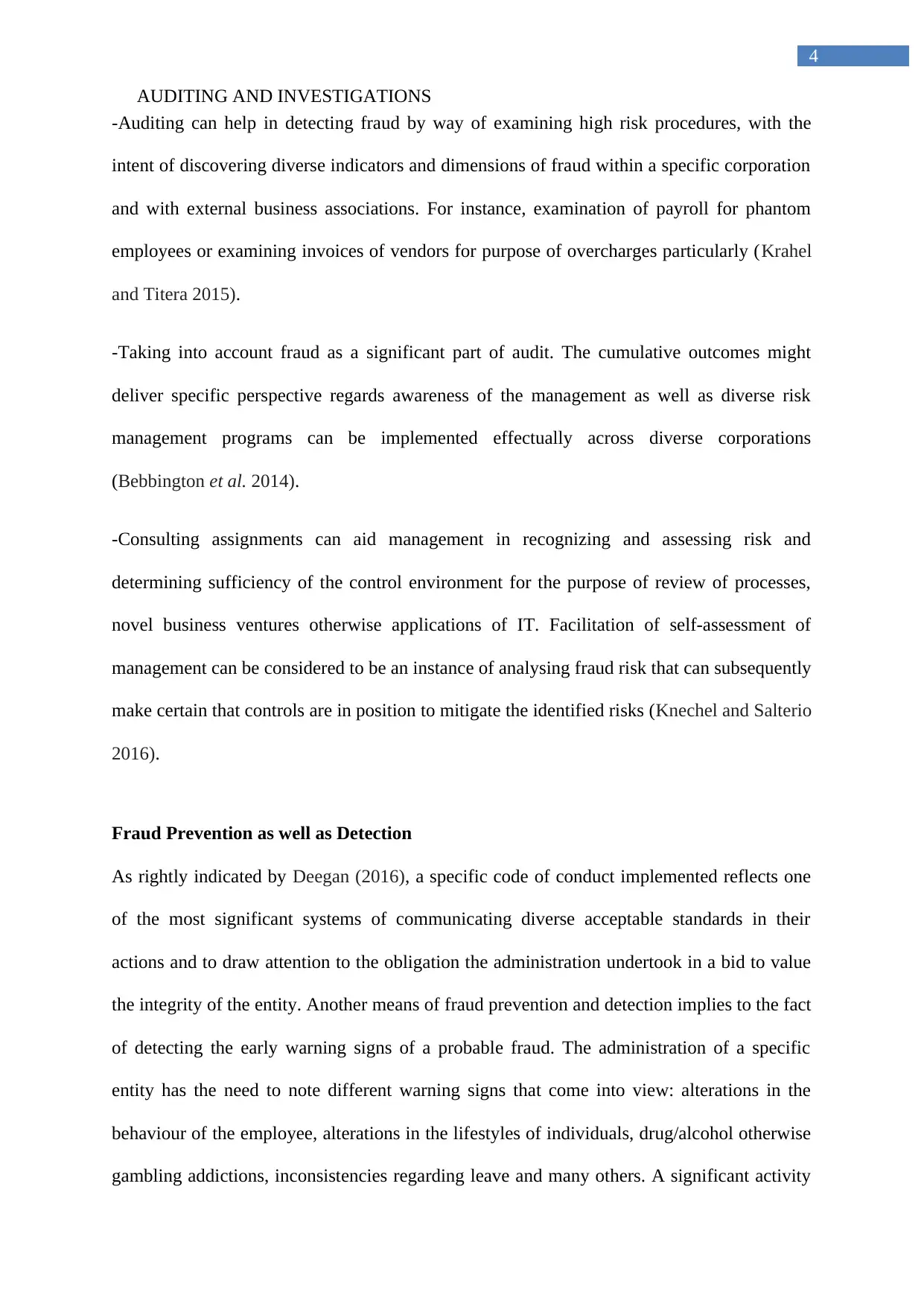
4
AUDITING AND INVESTIGATIONS
-Auditing can help in detecting fraud by way of examining high risk procedures, with the
intent of discovering diverse indicators and dimensions of fraud within a specific corporation
and with external business associations. For instance, examination of payroll for phantom
employees or examining invoices of vendors for purpose of overcharges particularly (Krahel
and Titera 2015).
-Taking into account fraud as a significant part of audit. The cumulative outcomes might
deliver specific perspective regards awareness of the management as well as diverse risk
management programs can be implemented effectually across diverse corporations
(Bebbington et al. 2014).
-Consulting assignments can aid management in recognizing and assessing risk and
determining sufficiency of the control environment for the purpose of review of processes,
novel business ventures otherwise applications of IT. Facilitation of self-assessment of
management can be considered to be an instance of analysing fraud risk that can subsequently
make certain that controls are in position to mitigate the identified risks (Knechel and Salterio
2016).
Fraud Prevention as well as Detection
As rightly indicated by Deegan (2016), a specific code of conduct implemented reflects one
of the most significant systems of communicating diverse acceptable standards in their
actions and to draw attention to the obligation the administration undertook in a bid to value
the integrity of the entity. Another means of fraud prevention and detection implies to the fact
of detecting the early warning signs of a probable fraud. The administration of a specific
entity has the need to note different warning signs that come into view: alterations in the
behaviour of the employee, alterations in the lifestyles of individuals, drug/alcohol otherwise
gambling addictions, inconsistencies regarding leave and many others. A significant activity
AUDITING AND INVESTIGATIONS
-Auditing can help in detecting fraud by way of examining high risk procedures, with the
intent of discovering diverse indicators and dimensions of fraud within a specific corporation
and with external business associations. For instance, examination of payroll for phantom
employees or examining invoices of vendors for purpose of overcharges particularly (Krahel
and Titera 2015).
-Taking into account fraud as a significant part of audit. The cumulative outcomes might
deliver specific perspective regards awareness of the management as well as diverse risk
management programs can be implemented effectually across diverse corporations
(Bebbington et al. 2014).
-Consulting assignments can aid management in recognizing and assessing risk and
determining sufficiency of the control environment for the purpose of review of processes,
novel business ventures otherwise applications of IT. Facilitation of self-assessment of
management can be considered to be an instance of analysing fraud risk that can subsequently
make certain that controls are in position to mitigate the identified risks (Knechel and Salterio
2016).
Fraud Prevention as well as Detection
As rightly indicated by Deegan (2016), a specific code of conduct implemented reflects one
of the most significant systems of communicating diverse acceptable standards in their
actions and to draw attention to the obligation the administration undertook in a bid to value
the integrity of the entity. Another means of fraud prevention and detection implies to the fact
of detecting the early warning signs of a probable fraud. The administration of a specific
entity has the need to note different warning signs that come into view: alterations in the
behaviour of the employee, alterations in the lifestyles of individuals, drug/alcohol otherwise
gambling addictions, inconsistencies regarding leave and many others. A significant activity
Paraphrase This Document
Need a fresh take? Get an instant paraphrase of this document with our AI Paraphraser
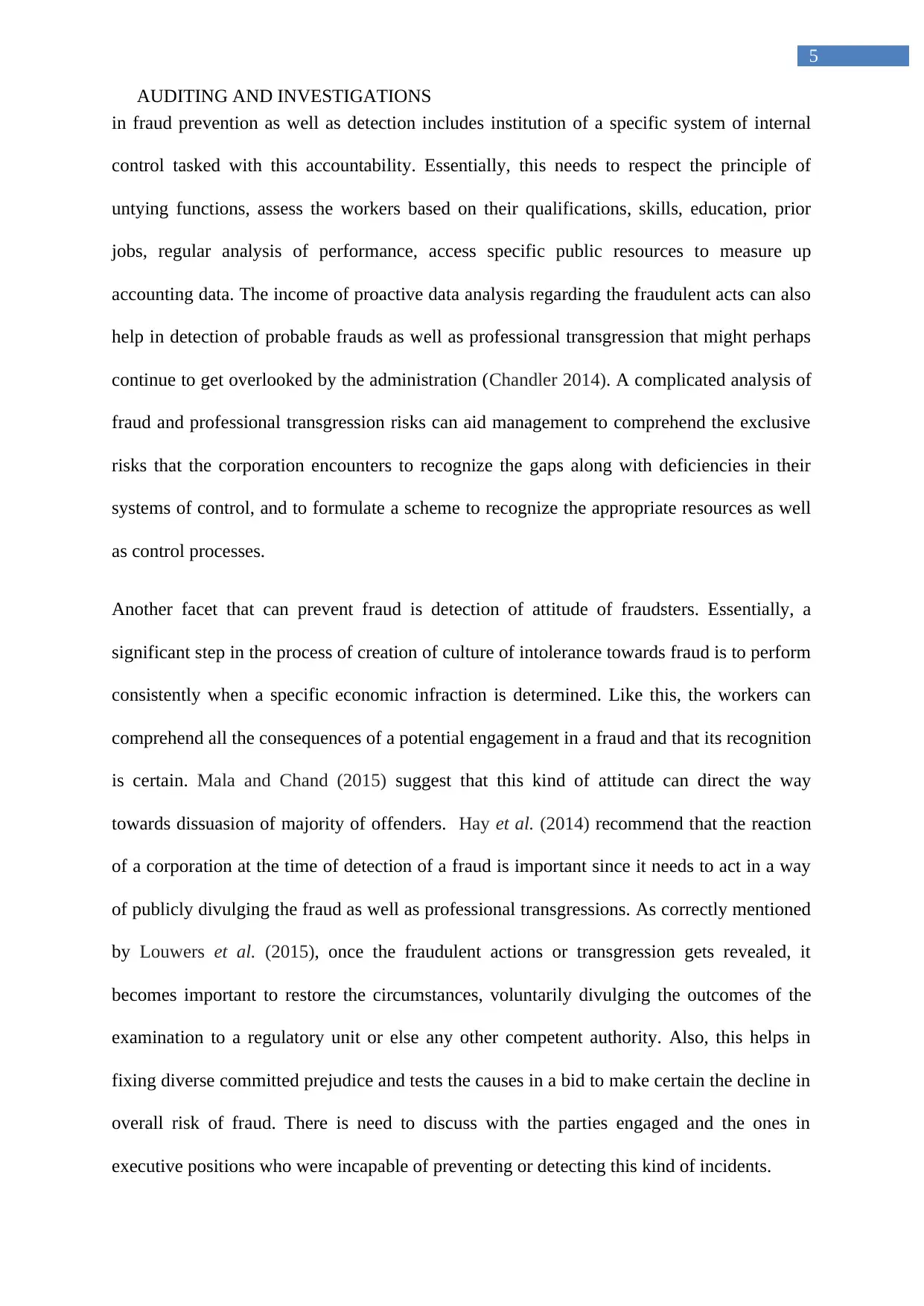
5
AUDITING AND INVESTIGATIONS
in fraud prevention as well as detection includes institution of a specific system of internal
control tasked with this accountability. Essentially, this needs to respect the principle of
untying functions, assess the workers based on their qualifications, skills, education, prior
jobs, regular analysis of performance, access specific public resources to measure up
accounting data. The income of proactive data analysis regarding the fraudulent acts can also
help in detection of probable frauds as well as professional transgression that might perhaps
continue to get overlooked by the administration (Chandler 2014). A complicated analysis of
fraud and professional transgression risks can aid management to comprehend the exclusive
risks that the corporation encounters to recognize the gaps along with deficiencies in their
systems of control, and to formulate a scheme to recognize the appropriate resources as well
as control processes.
Another facet that can prevent fraud is detection of attitude of fraudsters. Essentially, a
significant step in the process of creation of culture of intolerance towards fraud is to perform
consistently when a specific economic infraction is determined. Like this, the workers can
comprehend all the consequences of a potential engagement in a fraud and that its recognition
is certain. Mala and Chand (2015) suggest that this kind of attitude can direct the way
towards dissuasion of majority of offenders. Hay et al. (2014) recommend that the reaction
of a corporation at the time of detection of a fraud is important since it needs to act in a way
of publicly divulging the fraud as well as professional transgressions. As correctly mentioned
by Louwers et al. (2015), once the fraudulent actions or transgression gets revealed, it
becomes important to restore the circumstances, voluntarily divulging the outcomes of the
examination to a regulatory unit or else any other competent authority. Also, this helps in
fixing diverse committed prejudice and tests the causes in a bid to make certain the decline in
overall risk of fraud. There is need to discuss with the parties engaged and the ones in
executive positions who were incapable of preventing or detecting this kind of incidents.
AUDITING AND INVESTIGATIONS
in fraud prevention as well as detection includes institution of a specific system of internal
control tasked with this accountability. Essentially, this needs to respect the principle of
untying functions, assess the workers based on their qualifications, skills, education, prior
jobs, regular analysis of performance, access specific public resources to measure up
accounting data. The income of proactive data analysis regarding the fraudulent acts can also
help in detection of probable frauds as well as professional transgression that might perhaps
continue to get overlooked by the administration (Chandler 2014). A complicated analysis of
fraud and professional transgression risks can aid management to comprehend the exclusive
risks that the corporation encounters to recognize the gaps along with deficiencies in their
systems of control, and to formulate a scheme to recognize the appropriate resources as well
as control processes.
Another facet that can prevent fraud is detection of attitude of fraudsters. Essentially, a
significant step in the process of creation of culture of intolerance towards fraud is to perform
consistently when a specific economic infraction is determined. Like this, the workers can
comprehend all the consequences of a potential engagement in a fraud and that its recognition
is certain. Mala and Chand (2015) suggest that this kind of attitude can direct the way
towards dissuasion of majority of offenders. Hay et al. (2014) recommend that the reaction
of a corporation at the time of detection of a fraud is important since it needs to act in a way
of publicly divulging the fraud as well as professional transgressions. As correctly mentioned
by Louwers et al. (2015), once the fraudulent actions or transgression gets revealed, it
becomes important to restore the circumstances, voluntarily divulging the outcomes of the
examination to a regulatory unit or else any other competent authority. Also, this helps in
fixing diverse committed prejudice and tests the causes in a bid to make certain the decline in
overall risk of fraud. There is need to discuss with the parties engaged and the ones in
executive positions who were incapable of preventing or detecting this kind of incidents.
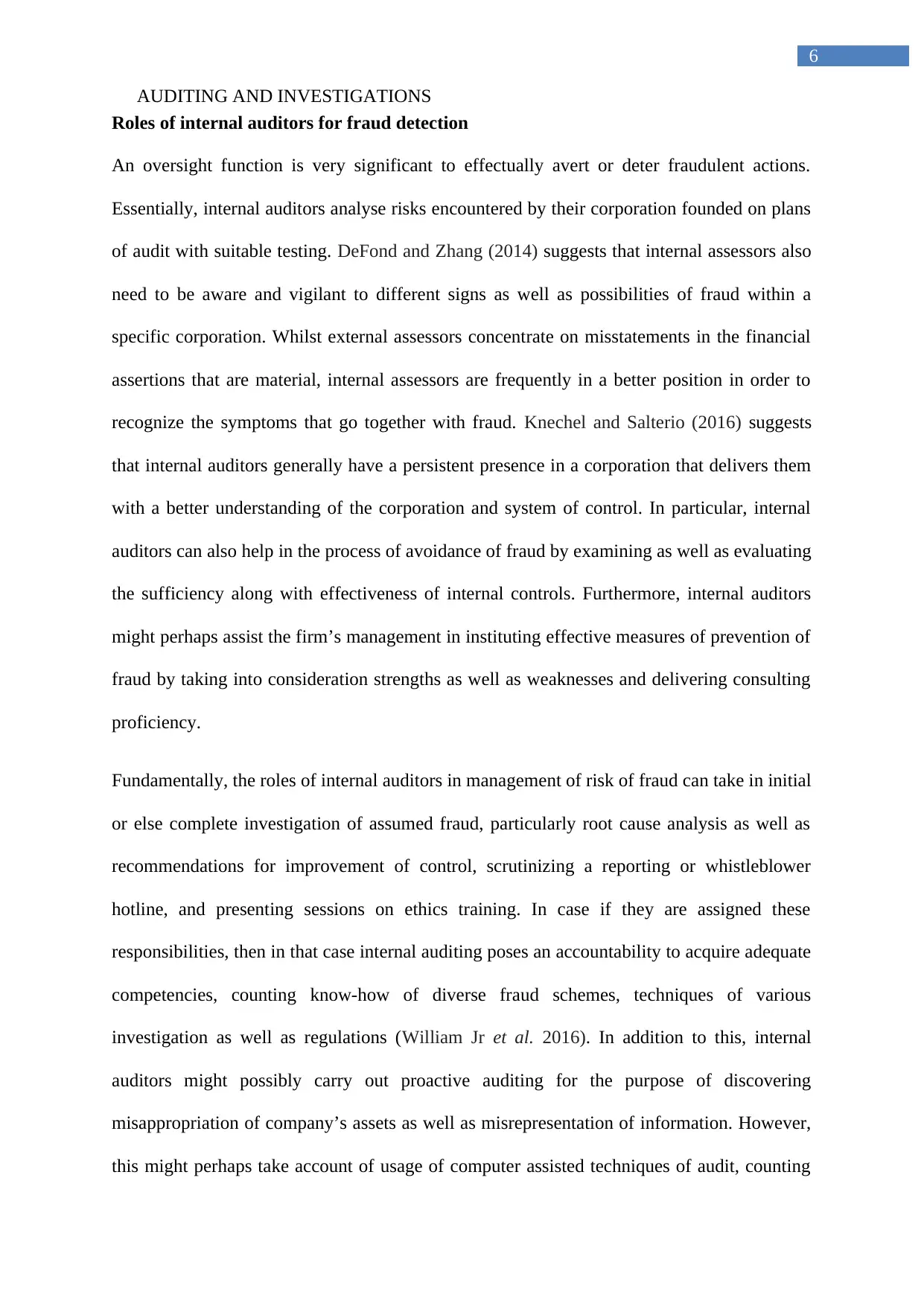
6
AUDITING AND INVESTIGATIONS
Roles of internal auditors for fraud detection
An oversight function is very significant to effectually avert or deter fraudulent actions.
Essentially, internal auditors analyse risks encountered by their corporation founded on plans
of audit with suitable testing. DeFond and Zhang (2014) suggests that internal assessors also
need to be aware and vigilant to different signs as well as possibilities of fraud within a
specific corporation. Whilst external assessors concentrate on misstatements in the financial
assertions that are material, internal assessors are frequently in a better position in order to
recognize the symptoms that go together with fraud. Knechel and Salterio (2016) suggests
that internal auditors generally have a persistent presence in a corporation that delivers them
with a better understanding of the corporation and system of control. In particular, internal
auditors can also help in the process of avoidance of fraud by examining as well as evaluating
the sufficiency along with effectiveness of internal controls. Furthermore, internal auditors
might perhaps assist the firm’s management in instituting effective measures of prevention of
fraud by taking into consideration strengths as well as weaknesses and delivering consulting
proficiency.
Fundamentally, the roles of internal auditors in management of risk of fraud can take in initial
or else complete investigation of assumed fraud, particularly root cause analysis as well as
recommendations for improvement of control, scrutinizing a reporting or whistleblower
hotline, and presenting sessions on ethics training. In case if they are assigned these
responsibilities, then in that case internal auditing poses an accountability to acquire adequate
competencies, counting know-how of diverse fraud schemes, techniques of various
investigation as well as regulations (William Jr et al. 2016). In addition to this, internal
auditors might possibly carry out proactive auditing for the purpose of discovering
misappropriation of company’s assets as well as misrepresentation of information. However,
this might perhaps take account of usage of computer assisted techniques of audit, counting
AUDITING AND INVESTIGATIONS
Roles of internal auditors for fraud detection
An oversight function is very significant to effectually avert or deter fraudulent actions.
Essentially, internal auditors analyse risks encountered by their corporation founded on plans
of audit with suitable testing. DeFond and Zhang (2014) suggests that internal assessors also
need to be aware and vigilant to different signs as well as possibilities of fraud within a
specific corporation. Whilst external assessors concentrate on misstatements in the financial
assertions that are material, internal assessors are frequently in a better position in order to
recognize the symptoms that go together with fraud. Knechel and Salterio (2016) suggests
that internal auditors generally have a persistent presence in a corporation that delivers them
with a better understanding of the corporation and system of control. In particular, internal
auditors can also help in the process of avoidance of fraud by examining as well as evaluating
the sufficiency along with effectiveness of internal controls. Furthermore, internal auditors
might perhaps assist the firm’s management in instituting effective measures of prevention of
fraud by taking into consideration strengths as well as weaknesses and delivering consulting
proficiency.
Fundamentally, the roles of internal auditors in management of risk of fraud can take in initial
or else complete investigation of assumed fraud, particularly root cause analysis as well as
recommendations for improvement of control, scrutinizing a reporting or whistleblower
hotline, and presenting sessions on ethics training. In case if they are assigned these
responsibilities, then in that case internal auditing poses an accountability to acquire adequate
competencies, counting know-how of diverse fraud schemes, techniques of various
investigation as well as regulations (William Jr et al. 2016). In addition to this, internal
auditors might possibly carry out proactive auditing for the purpose of discovering
misappropriation of company’s assets as well as misrepresentation of information. However,
this might perhaps take account of usage of computer assisted techniques of audit, counting
⊘ This is a preview!⊘
Do you want full access?
Subscribe today to unlock all pages.

Trusted by 1+ million students worldwide
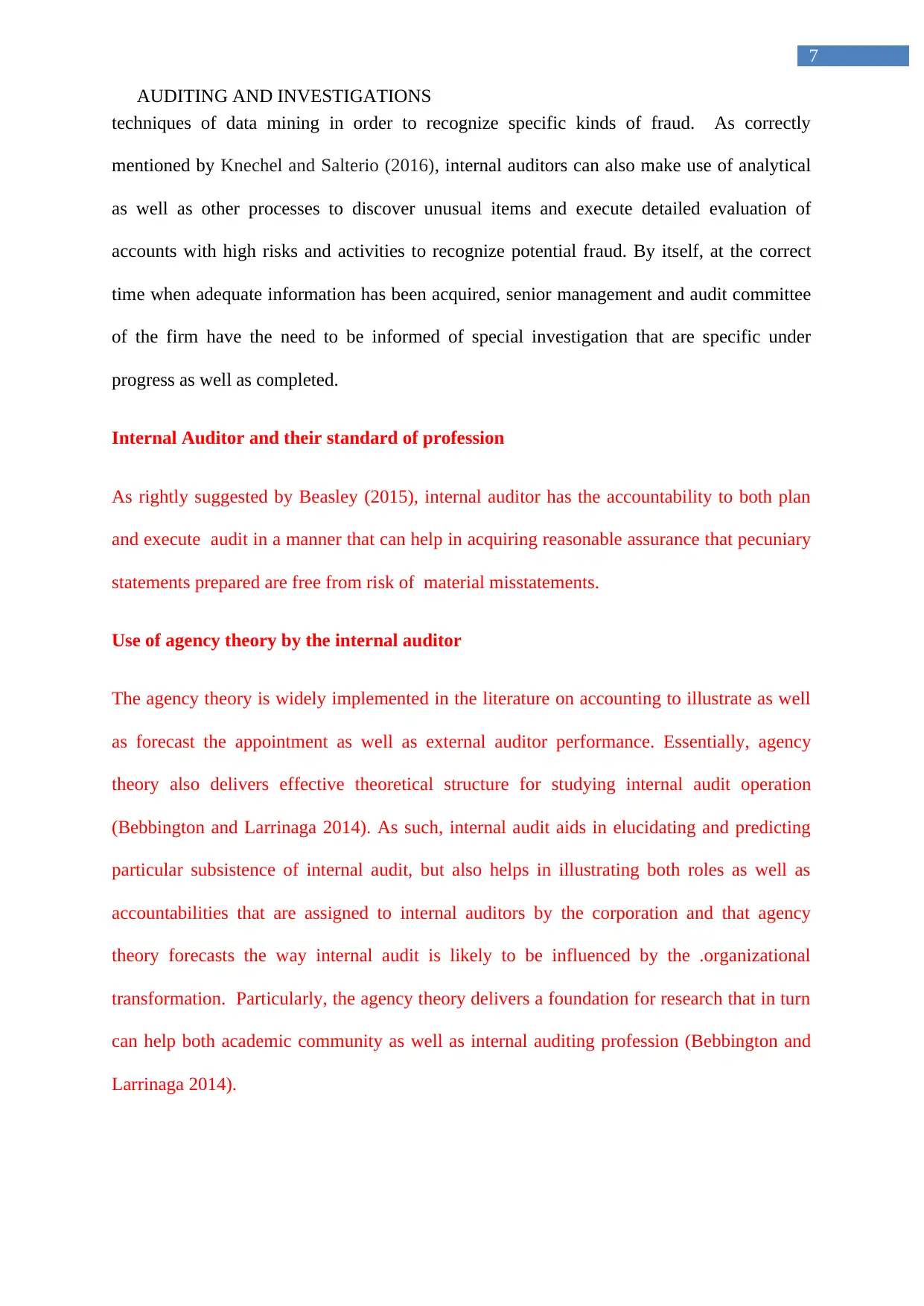
7
AUDITING AND INVESTIGATIONS
techniques of data mining in order to recognize specific kinds of fraud. As correctly
mentioned by Knechel and Salterio (2016), internal auditors can also make use of analytical
as well as other processes to discover unusual items and execute detailed evaluation of
accounts with high risks and activities to recognize potential fraud. By itself, at the correct
time when adequate information has been acquired, senior management and audit committee
of the firm have the need to be informed of special investigation that are specific under
progress as well as completed.
Internal Auditor and their standard of profession
As rightly suggested by Beasley (2015), internal auditor has the accountability to both plan
and execute audit in a manner that can help in acquiring reasonable assurance that pecuniary
statements prepared are free from risk of material misstatements.
Use of agency theory by the internal auditor
The agency theory is widely implemented in the literature on accounting to illustrate as well
as forecast the appointment as well as external auditor performance. Essentially, agency
theory also delivers effective theoretical structure for studying internal audit operation
(Bebbington and Larrinaga 2014). As such, internal audit aids in elucidating and predicting
particular subsistence of internal audit, but also helps in illustrating both roles as well as
accountabilities that are assigned to internal auditors by the corporation and that agency
theory forecasts the way internal audit is likely to be influenced by the .organizational
transformation. Particularly, the agency theory delivers a foundation for research that in turn
can help both academic community as well as internal auditing profession (Bebbington and
Larrinaga 2014).
AUDITING AND INVESTIGATIONS
techniques of data mining in order to recognize specific kinds of fraud. As correctly
mentioned by Knechel and Salterio (2016), internal auditors can also make use of analytical
as well as other processes to discover unusual items and execute detailed evaluation of
accounts with high risks and activities to recognize potential fraud. By itself, at the correct
time when adequate information has been acquired, senior management and audit committee
of the firm have the need to be informed of special investigation that are specific under
progress as well as completed.
Internal Auditor and their standard of profession
As rightly suggested by Beasley (2015), internal auditor has the accountability to both plan
and execute audit in a manner that can help in acquiring reasonable assurance that pecuniary
statements prepared are free from risk of material misstatements.
Use of agency theory by the internal auditor
The agency theory is widely implemented in the literature on accounting to illustrate as well
as forecast the appointment as well as external auditor performance. Essentially, agency
theory also delivers effective theoretical structure for studying internal audit operation
(Bebbington and Larrinaga 2014). As such, internal audit aids in elucidating and predicting
particular subsistence of internal audit, but also helps in illustrating both roles as well as
accountabilities that are assigned to internal auditors by the corporation and that agency
theory forecasts the way internal audit is likely to be influenced by the .organizational
transformation. Particularly, the agency theory delivers a foundation for research that in turn
can help both academic community as well as internal auditing profession (Bebbington and
Larrinaga 2014).
Paraphrase This Document
Need a fresh take? Get an instant paraphrase of this document with our AI Paraphraser

8
AUDITING AND INVESTIGATIONS
Internal auditors can make use of agency theory in case where there is a thin line of division
from ownership of corporations and the management. Fundamentally, this can be regarded as
the agency theory. In essence, it is liability of the auditor to detect the base level frauds of the
corporation. Furthermore, accountability of the internal auditor is also to pronounce the errors
directly to the administration of the corporation (Bebbington and Larrinaga 2014).
Types of internal audits
Different types of internal audit that are executed by the internal auditors of a firm are as
mentioned below:
-Operational Audit: Operational audit helps in making it certain that the efficient as well as
effectual conduct of functionalities of a corporation (Canning and O'Dwyer 2016).
-Performance Audit: Performance audit helps in making certain the effective utilization of
company’s resources to attain goals of the corporation
-Compliance Audit: Compliance audit helps in ensuring the maintenance of compliance
with thee pertinent regulations that are implemented on a particular corporation (Canning and
O'Dwyer 2016).
Challenges encountered by internal auditor
The challenges encountered by the internal auditor include the following:
-Enhancement in fraudulent world of business
According to the study presented by the Institute of Management Accountants, around 87%
of the managers were inclined to commit fraud in circumstances as well as cases where those
fraudulent actions would help the firm in development (Canning and O'Dwyer 2016).
-New technology that helps in creation of new kinds of fraud
AUDITING AND INVESTIGATIONS
Internal auditors can make use of agency theory in case where there is a thin line of division
from ownership of corporations and the management. Fundamentally, this can be regarded as
the agency theory. In essence, it is liability of the auditor to detect the base level frauds of the
corporation. Furthermore, accountability of the internal auditor is also to pronounce the errors
directly to the administration of the corporation (Bebbington and Larrinaga 2014).
Types of internal audits
Different types of internal audit that are executed by the internal auditors of a firm are as
mentioned below:
-Operational Audit: Operational audit helps in making it certain that the efficient as well as
effectual conduct of functionalities of a corporation (Canning and O'Dwyer 2016).
-Performance Audit: Performance audit helps in making certain the effective utilization of
company’s resources to attain goals of the corporation
-Compliance Audit: Compliance audit helps in ensuring the maintenance of compliance
with thee pertinent regulations that are implemented on a particular corporation (Canning and
O'Dwyer 2016).
Challenges encountered by internal auditor
The challenges encountered by the internal auditor include the following:
-Enhancement in fraudulent world of business
According to the study presented by the Institute of Management Accountants, around 87%
of the managers were inclined to commit fraud in circumstances as well as cases where those
fraudulent actions would help the firm in development (Canning and O'Dwyer 2016).
-New technology that helps in creation of new kinds of fraud

9
AUDITING AND INVESTIGATIONS
Innovative and advanced technology aids the fraud individual in generating new categories of
fraudulent activities in the corporation.
-Standards of profession are quite clear
The internal control necessarily has the accountability to both plan and execute the work of
audit in a manner that it can acquire reasonable assurance that the financial statements
prepared are necessarily free from particularly material misstatements (Chandler 2014).
-Difficulty in the process of detection of fraud and error in a corporation
As per prior research study, it can be hereby said that internal auditor is necessarily not the
primary observers of frau d in a specific corporation.
Differences that exist between internal and external audit
The external auditors of a corporation have the accountability of adhering to specific
professional standards and to develop and execute audit of financial declarations of
corporation. This can help in obtaining reasonable assurance as regards whether financial
statements of the firm are liberated of material misstatement and whether financial statements
are caused by error or else fraud (Chandler 2014). External auditor can ascertain whether the
misstatements were created by mistakes or else fraud. Again, when the external assessor has
ascertained there is substantiation that fraudulent actions might exist; external auditor’s
professional standards characteristically require that the theme be brought to the notice of a
suitable level of management (William Jr et al. 2016). The external assessor typically
AUDITING AND INVESTIGATIONS
Innovative and advanced technology aids the fraud individual in generating new categories of
fraudulent activities in the corporation.
-Standards of profession are quite clear
The internal control necessarily has the accountability to both plan and execute the work of
audit in a manner that it can acquire reasonable assurance that the financial statements
prepared are necessarily free from particularly material misstatements (Chandler 2014).
-Difficulty in the process of detection of fraud and error in a corporation
As per prior research study, it can be hereby said that internal auditor is necessarily not the
primary observers of frau d in a specific corporation.
Differences that exist between internal and external audit
The external auditors of a corporation have the accountability of adhering to specific
professional standards and to develop and execute audit of financial declarations of
corporation. This can help in obtaining reasonable assurance as regards whether financial
statements of the firm are liberated of material misstatement and whether financial statements
are caused by error or else fraud (Chandler 2014). External auditor can ascertain whether the
misstatements were created by mistakes or else fraud. Again, when the external assessor has
ascertained there is substantiation that fraudulent actions might exist; external auditor’s
professional standards characteristically require that the theme be brought to the notice of a
suitable level of management (William Jr et al. 2016). The external assessor typically
⊘ This is a preview!⊘
Do you want full access?
Subscribe today to unlock all pages.

Trusted by 1+ million students worldwide
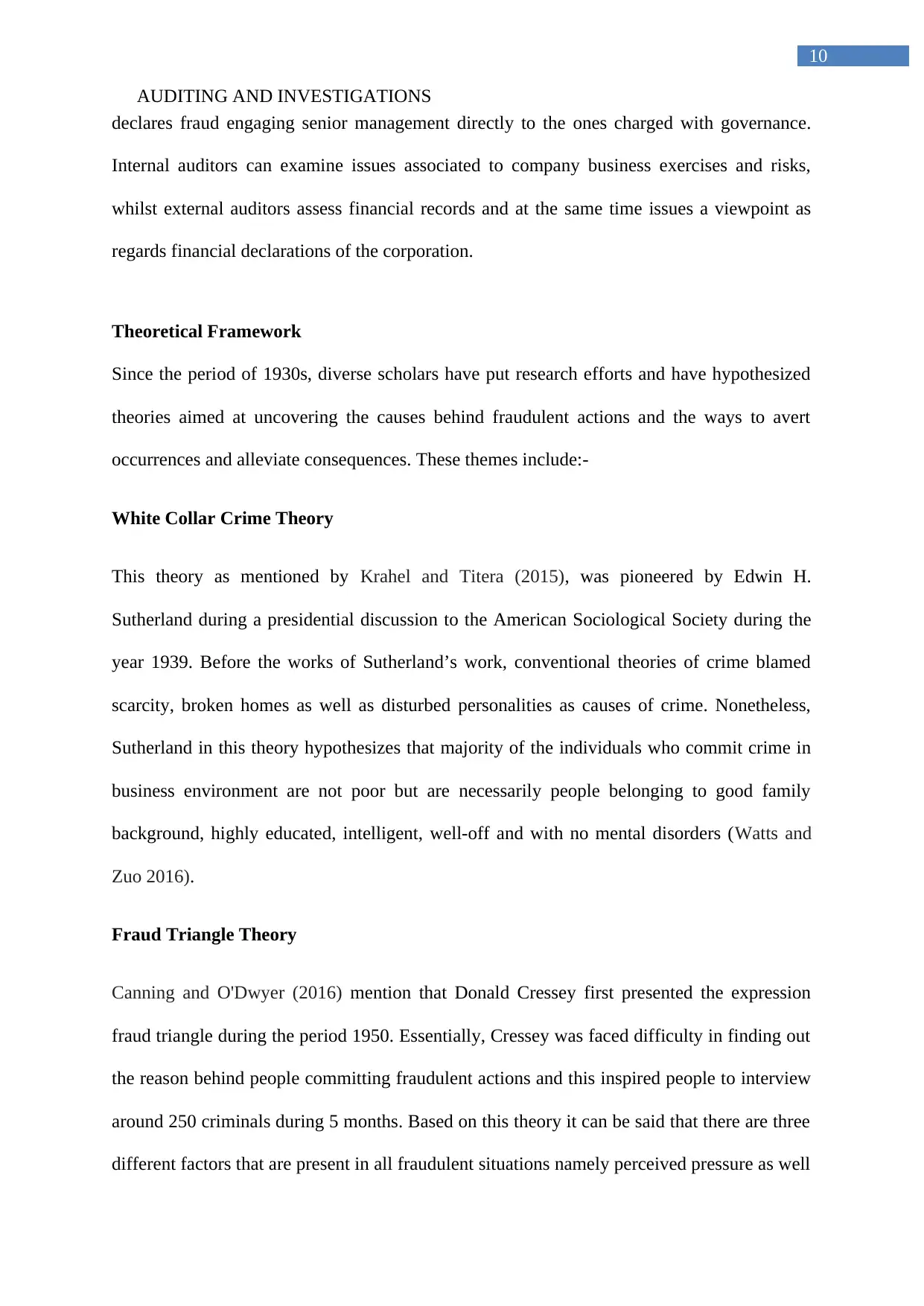
10
AUDITING AND INVESTIGATIONS
declares fraud engaging senior management directly to the ones charged with governance.
Internal auditors can examine issues associated to company business exercises and risks,
whilst external auditors assess financial records and at the same time issues a viewpoint as
regards financial declarations of the corporation.
Theoretical Framework
Since the period of 1930s, diverse scholars have put research efforts and have hypothesized
theories aimed at uncovering the causes behind fraudulent actions and the ways to avert
occurrences and alleviate consequences. These themes include:-
White Collar Crime Theory
This theory as mentioned by Krahel and Titera (2015), was pioneered by Edwin H.
Sutherland during a presidential discussion to the American Sociological Society during the
year 1939. Before the works of Sutherland’s work, conventional theories of crime blamed
scarcity, broken homes as well as disturbed personalities as causes of crime. Nonetheless,
Sutherland in this theory hypothesizes that majority of the individuals who commit crime in
business environment are not poor but are necessarily people belonging to good family
background, highly educated, intelligent, well-off and with no mental disorders (Watts and
Zuo 2016).
Fraud Triangle Theory
Canning and O'Dwyer (2016) mention that Donald Cressey first presented the expression
fraud triangle during the period 1950. Essentially, Cressey was faced difficulty in finding out
the reason behind people committing fraudulent actions and this inspired people to interview
around 250 criminals during 5 months. Based on this theory it can be said that there are three
different factors that are present in all fraudulent situations namely perceived pressure as well
AUDITING AND INVESTIGATIONS
declares fraud engaging senior management directly to the ones charged with governance.
Internal auditors can examine issues associated to company business exercises and risks,
whilst external auditors assess financial records and at the same time issues a viewpoint as
regards financial declarations of the corporation.
Theoretical Framework
Since the period of 1930s, diverse scholars have put research efforts and have hypothesized
theories aimed at uncovering the causes behind fraudulent actions and the ways to avert
occurrences and alleviate consequences. These themes include:-
White Collar Crime Theory
This theory as mentioned by Krahel and Titera (2015), was pioneered by Edwin H.
Sutherland during a presidential discussion to the American Sociological Society during the
year 1939. Before the works of Sutherland’s work, conventional theories of crime blamed
scarcity, broken homes as well as disturbed personalities as causes of crime. Nonetheless,
Sutherland in this theory hypothesizes that majority of the individuals who commit crime in
business environment are not poor but are necessarily people belonging to good family
background, highly educated, intelligent, well-off and with no mental disorders (Watts and
Zuo 2016).
Fraud Triangle Theory
Canning and O'Dwyer (2016) mention that Donald Cressey first presented the expression
fraud triangle during the period 1950. Essentially, Cressey was faced difficulty in finding out
the reason behind people committing fraudulent actions and this inspired people to interview
around 250 criminals during 5 months. Based on this theory it can be said that there are three
different factors that are present in all fraudulent situations namely perceived pressure as well
Paraphrase This Document
Need a fresh take? Get an instant paraphrase of this document with our AI Paraphraser
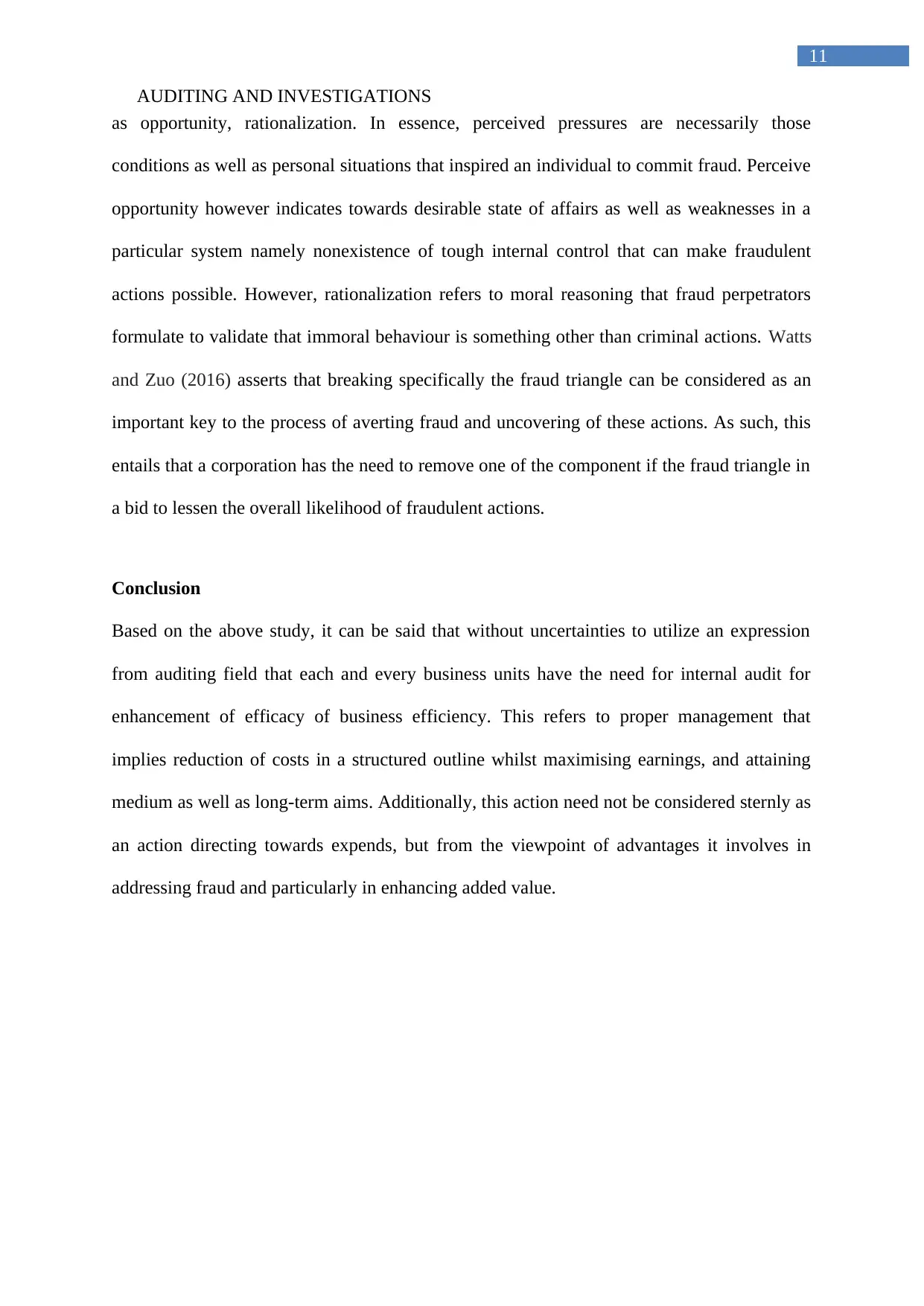
11
AUDITING AND INVESTIGATIONS
as opportunity, rationalization. In essence, perceived pressures are necessarily those
conditions as well as personal situations that inspired an individual to commit fraud. Perceive
opportunity however indicates towards desirable state of affairs as well as weaknesses in a
particular system namely nonexistence of tough internal control that can make fraudulent
actions possible. However, rationalization refers to moral reasoning that fraud perpetrators
formulate to validate that immoral behaviour is something other than criminal actions. Watts
and Zuo (2016) asserts that breaking specifically the fraud triangle can be considered as an
important key to the process of averting fraud and uncovering of these actions. As such, this
entails that a corporation has the need to remove one of the component if the fraud triangle in
a bid to lessen the overall likelihood of fraudulent actions.
Conclusion
Based on the above study, it can be said that without uncertainties to utilize an expression
from auditing field that each and every business units have the need for internal audit for
enhancement of efficacy of business efficiency. This refers to proper management that
implies reduction of costs in a structured outline whilst maximising earnings, and attaining
medium as well as long-term aims. Additionally, this action need not be considered sternly as
an action directing towards expends, but from the viewpoint of advantages it involves in
addressing fraud and particularly in enhancing added value.
AUDITING AND INVESTIGATIONS
as opportunity, rationalization. In essence, perceived pressures are necessarily those
conditions as well as personal situations that inspired an individual to commit fraud. Perceive
opportunity however indicates towards desirable state of affairs as well as weaknesses in a
particular system namely nonexistence of tough internal control that can make fraudulent
actions possible. However, rationalization refers to moral reasoning that fraud perpetrators
formulate to validate that immoral behaviour is something other than criminal actions. Watts
and Zuo (2016) asserts that breaking specifically the fraud triangle can be considered as an
important key to the process of averting fraud and uncovering of these actions. As such, this
entails that a corporation has the need to remove one of the component if the fraud triangle in
a bid to lessen the overall likelihood of fraudulent actions.
Conclusion
Based on the above study, it can be said that without uncertainties to utilize an expression
from auditing field that each and every business units have the need for internal audit for
enhancement of efficacy of business efficiency. This refers to proper management that
implies reduction of costs in a structured outline whilst maximising earnings, and attaining
medium as well as long-term aims. Additionally, this action need not be considered sternly as
an action directing towards expends, but from the viewpoint of advantages it involves in
addressing fraud and particularly in enhancing added value.
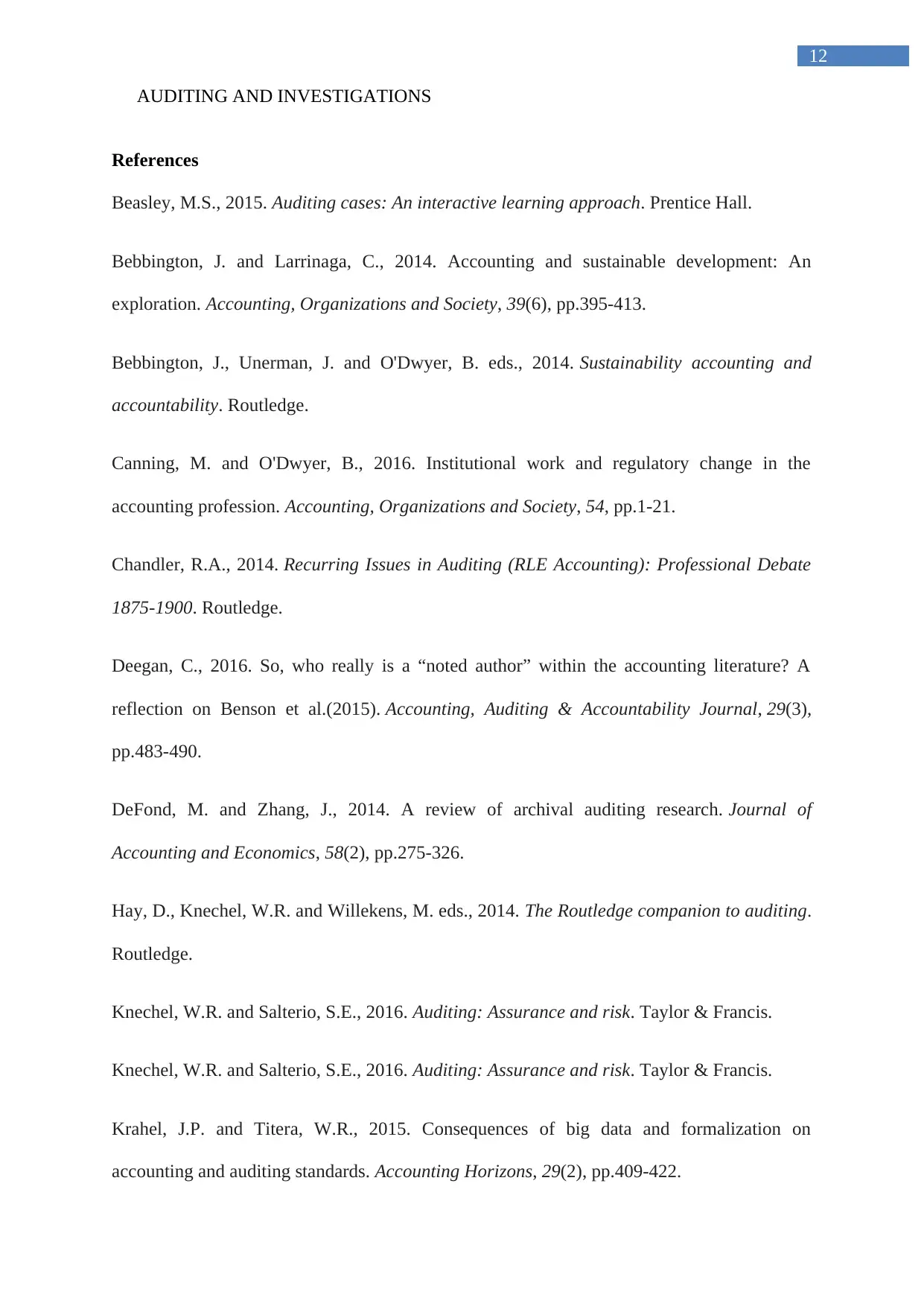
12
AUDITING AND INVESTIGATIONS
References
Beasley, M.S., 2015. Auditing cases: An interactive learning approach. Prentice Hall.
Bebbington, J. and Larrinaga, C., 2014. Accounting and sustainable development: An
exploration. Accounting, Organizations and Society, 39(6), pp.395-413.
Bebbington, J., Unerman, J. and O'Dwyer, B. eds., 2014. Sustainability accounting and
accountability. Routledge.
Canning, M. and O'Dwyer, B., 2016. Institutional work and regulatory change in the
accounting profession. Accounting, Organizations and Society, 54, pp.1-21.
Chandler, R.A., 2014. Recurring Issues in Auditing (RLE Accounting): Professional Debate
1875-1900. Routledge.
Deegan, C., 2016. So, who really is a “noted author” within the accounting literature? A
reflection on Benson et al.(2015). Accounting, Auditing & Accountability Journal, 29(3),
pp.483-490.
DeFond, M. and Zhang, J., 2014. A review of archival auditing research. Journal of
Accounting and Economics, 58(2), pp.275-326.
Hay, D., Knechel, W.R. and Willekens, M. eds., 2014. The Routledge companion to auditing.
Routledge.
Knechel, W.R. and Salterio, S.E., 2016. Auditing: Assurance and risk. Taylor & Francis.
Knechel, W.R. and Salterio, S.E., 2016. Auditing: Assurance and risk. Taylor & Francis.
Krahel, J.P. and Titera, W.R., 2015. Consequences of big data and formalization on
accounting and auditing standards. Accounting Horizons, 29(2), pp.409-422.
AUDITING AND INVESTIGATIONS
References
Beasley, M.S., 2015. Auditing cases: An interactive learning approach. Prentice Hall.
Bebbington, J. and Larrinaga, C., 2014. Accounting and sustainable development: An
exploration. Accounting, Organizations and Society, 39(6), pp.395-413.
Bebbington, J., Unerman, J. and O'Dwyer, B. eds., 2014. Sustainability accounting and
accountability. Routledge.
Canning, M. and O'Dwyer, B., 2016. Institutional work and regulatory change in the
accounting profession. Accounting, Organizations and Society, 54, pp.1-21.
Chandler, R.A., 2014. Recurring Issues in Auditing (RLE Accounting): Professional Debate
1875-1900. Routledge.
Deegan, C., 2016. So, who really is a “noted author” within the accounting literature? A
reflection on Benson et al.(2015). Accounting, Auditing & Accountability Journal, 29(3),
pp.483-490.
DeFond, M. and Zhang, J., 2014. A review of archival auditing research. Journal of
Accounting and Economics, 58(2), pp.275-326.
Hay, D., Knechel, W.R. and Willekens, M. eds., 2014. The Routledge companion to auditing.
Routledge.
Knechel, W.R. and Salterio, S.E., 2016. Auditing: Assurance and risk. Taylor & Francis.
Knechel, W.R. and Salterio, S.E., 2016. Auditing: Assurance and risk. Taylor & Francis.
Krahel, J.P. and Titera, W.R., 2015. Consequences of big data and formalization on
accounting and auditing standards. Accounting Horizons, 29(2), pp.409-422.
⊘ This is a preview!⊘
Do you want full access?
Subscribe today to unlock all pages.

Trusted by 1+ million students worldwide
1 out of 13
Related Documents
Your All-in-One AI-Powered Toolkit for Academic Success.
+13062052269
info@desklib.com
Available 24*7 on WhatsApp / Email
![[object Object]](/_next/static/media/star-bottom.7253800d.svg)
Unlock your academic potential
Copyright © 2020–2025 A2Z Services. All Rights Reserved. Developed and managed by ZUCOL.





